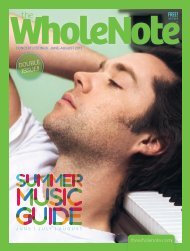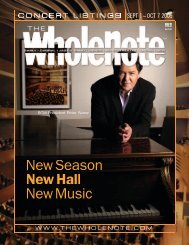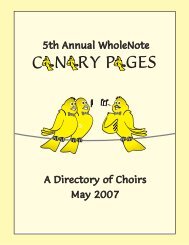PDF Version
PDF Version
PDF Version
- No tags were found...
You also want an ePaper? Increase the reach of your titles
YUMPU automatically turns print PDFs into web optimized ePapers that Google loves.
I mentioned earlier in this article have to dospecifically with these two discs. Each of thesymphonies is accompanied by what I wouldcall an incidental piece. Although the premiseof each — St. Thomas Wake (Foxtrot fororchestra on a pavan by John Bull) and CrossLane Fair — is “serious” enough, with separatedance band and Northumbrian pipesand bodhran respectively, they come acrossas merely pastiche. This is not to suggest thatthey are not a worthy part of Maxwell Davies’oeuvre, simply that I would prefer a so-called“separation of church and state” — discs ofsymphonic repertoire on the one hand and ofthe more theatrical music on another.With my space rapidly running out I willjust briefly mention my “old favourites”revisited in recent Naxos recordings.The abrasive music of then young Polishcomposer Krzysztof Penderecki was animportant aspect of my introduction to themusic of the 20th century. There have been anumber of recent Naxos Penderecki releases,each of which combines his youthful outputwith more conservative works of his matureyears. Fonogrammi/Horn Concerto/Partita(8.572482) includes Fonogrammi for flute andchamber orchestra, Anaklasis for stringorchestra and percussion and De natura sonorisI for orchestra, all from the 1960s, withseveral works from the 70s and the muchmore recent Horn Concerto “Winterreise”(2009). With a variety of soloists the WarsawPhilharmonic Orchestra and Anthony Witprovide definitive performances.Olivier Messiaen’sEt exspecto resurrectionemmortuorum(8.572714) is a devotionalwork from 1964.The OrchestreNational de Lyon givesa strong performanceunder the direction ofJun Märki, but without ecstatic interludessuch as those included in the earlierTurangalîla Symphony, to my ears the pieceis a little “too much of a muchness.” The discis redeemed however by the inclusion of twoearly orchestral works which provide welcomedramatic contrast: Le Tombeauresplendissant (1931) and Hymne (1932).Saving the bestfor last, MarinAlsop returns witha recording ofBartók’s Concertofor Orchestra (1943)and Music forStrings, Percussionand Celesta (1936)(8.572486). In this instance she is conductingthe Baltimore Symphony Orchestrain performances that rival any I’ve heard ofthese two works which number among myvery favourites.Naxos is to be commended for its commitmentto thoroughness, excellence andaffordability. This small sampling of recentoutput only includes the art music of ourtime. It must be pointed out that the Naxoscatalogue is just as extensive, one could sayexhaustive, in classical repertoire from theRenaissance through the Baroque, Classicaland Romantic eras. And as Nicholas Soames,author of The Story of Naxos and directorof Naxos AudioBooks would certainlypoint out, the Naxos catalogue extends farbeyond the scope of classical music. Thereare two things I look forward to in the comingmonth: finding the time to read Soames’story of this innovative company that haschanged the history of recorded music in ourtime, and the newest addition to the NaxosCanadian Classics series, Dreamscapes, featuringorchestral music by Vivian Fung dueout on September 23.Of related interest: Jerry Fink, formerCEO and President of Naxos of Canada Ltd.,will present a ten-week class surveying thehistory of Western “classical” music from aJewish viewpoint. Jewish involvement in thedevelopment of “classical” music from beforethe Byzantine Empire to the present daywill be explored historically and examinedmusically. Examples from the presentationinclude: the Psalms and their use inChristian church music; Jewish troubadoursof the Middle Ages; a Jewish national musicschool in pre-Soviet Russia. Thursday eveningsbeginning October 4 at Holy BlossomTemple. Tuition fee $235 (416-789-7400).We welcome your feedback and invitesubmissions. CDs and comments should besent to: The WholeNote, 503–720 BathurstSt., Toronto ON M5S 2R4. We also encourageyou to visit our website, thewholenote.com,where you can find added features includingdirect links to performers, composers andrecord labels, and additional, expanded andarchival reviews.— David Olds, DISCoveries Editordiscoveries@thewholenote.comFEELING LUCKY?THREE WAYS TO WINCDs, tickets and othermusical prizes courtesy ofThe WholeNote1. Join our mailing list byregistering atwww.thewholenote.com2. Like us on Facebook3. Follow us on Twitterthewholenote.comEARLY & PERIOD PERFORMANCETwo Lutes – Lute Duets fromEngland’s Golden AgeRonn McFarlane; William SimmsSono Luminus DSL-92155!!Lute duets formsome of the mostenchanting and atthe same time mostdemanding recitals.Imagine a selection of27 such duets!La Rossignal hasalways been a testingbut satisfying example of the genre. Both lutenistsbring out the disciplined yet exuberantquality of this piece; they follow immediatelywith the stately and measured Delight Pavanof John Johnson, 15 years Queen Elizabeth’s“royal lewter.”Ronn McFarlane and William Simms havegone well beyond formal compositions byElizabethan composers — the anonymousRobin is to the Greenwood Gone is performedwith a dedication and passion whichDowland and his contemporaries would havefelt honoured by.Then there are the sadly less well-knowncomposers. Who can listen to the complexityof John Danyel’s Passemezzo Galliard and notwonder not just at the complexity of the galliardbut also the performance to which weare treated? Listeners can even enjoy ThomasRobinson’s Passamezzo Galliard and comparethe two, notably their slow almost labouredopening bars.Johnson it is, however, who contributesthe most duets. His Chi Passa (which differsconsiderably from the Commedia dell’arteversion normally found), Queen’s Treble andFlatt Pavan and Galliard (was ever a compositionso inappropriately named?) areinterpreted so as to lend no doubt as to howlong the players have been a duet.This reviewer tried to make notes while listeningto the duets. He was persistently butvery happily prevented by the sheer pleasureof their content.—Michael SchwartzVivaldi – New Discoveries IIModo Antiquo; Federico Maria SardelliNaïve OP 30534!!The story behindthis disc is a fascinatingone. As explainedin the handsomeand comprehensiveaccompanying booklet,the recording ismade up entirely ofnewly-discoveredoperatic and instrumental music by Vivaldi,found over the past 20 years in various privateand public collections in England, Scotland,Belgium and Germany. These include aSeptember 1 – October 7, 2012 thewholenote.com 61
















